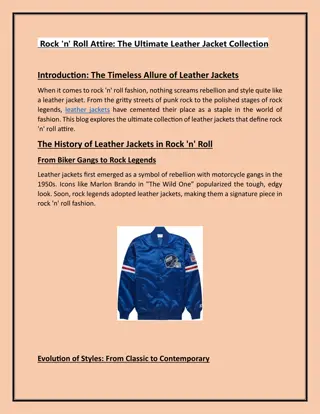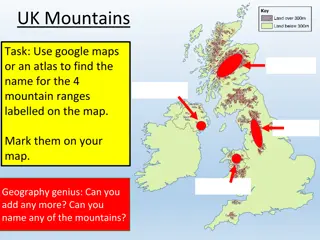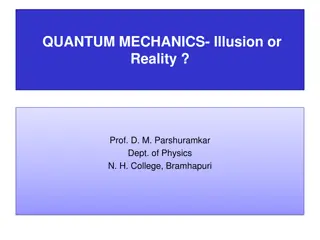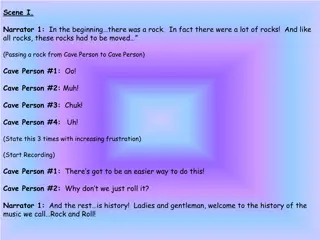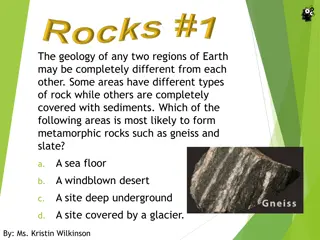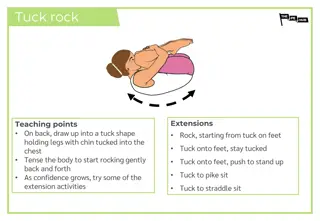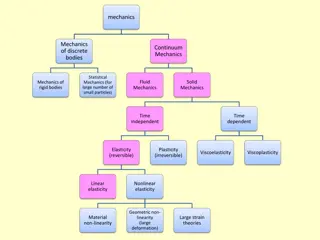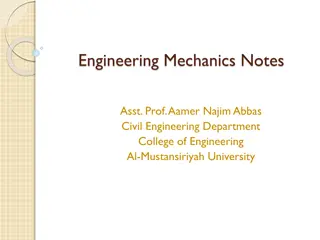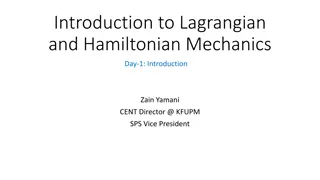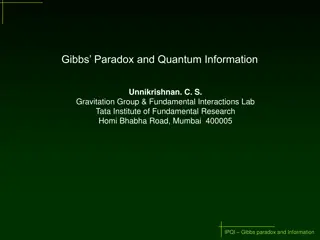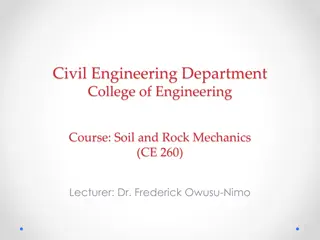Comprehensive Overview of Rock Mechanics Module at TISHK International University
This module at TISHK International University delves into the fundamental and advanced concepts of rock mechanics, focusing on design and stabilization of excavations in rock masses. Students gain knowledge on stress, strain, and elasticity relationships in rock masses, enabling them to characterize rock materials, identify discontinuity features, design structures, assess slope stability, and calculate Rock Mass Rating. The module also covers important principles such as Mohr-Coulomb criteria and Hoek-Brown failure criteria. Through this course, students develop a thorough understanding of rock mechanics technical terms and practical applications in mining and engineering projects.
Download Presentation

Please find below an Image/Link to download the presentation.
The content on the website is provided AS IS for your information and personal use only. It may not be sold, licensed, or shared on other websites without obtaining consent from the author.If you encounter any issues during the download, it is possible that the publisher has removed the file from their server.
You are allowed to download the files provided on this website for personal or commercial use, subject to the condition that they are used lawfully. All files are the property of their respective owners.
The content on the website is provided AS IS for your information and personal use only. It may not be sold, licensed, or shared on other websites without obtaining consent from the author.
E N D
Presentation Transcript
TISHK INTERNATIONAL UNIVERSITY TISHK INTERNATIONAL UNIVERSITY Rock Mechanics TEC 18 Professor, Dr. Hamed M. Jassim Week 1 INTRODUCTION
TISHK INTERNATIONAL UNIVERSITY TISHK INTERNATIONAL UNIVERSITY Module Information ROCK MECHANICS Credit Rating Semester of Delivery Module Title Module Code TEC 18 3 Fall Term/ Semester 3 Module Level UG 3 Administering Department Petroleum and Mining Engineering Module Leader Module Tutors Programs for which this module is core Programs for which this module is elective Date Approved Professor, Dr. Hamed M. Jassim Petroleum and Mining Engineering NA 1 Sept. 2019 Version Number
TISHK INTERNATIONAL UNIVERSITY TISHK INTERNATIONAL UNIVERSITY Module Aims, Learning Outcomes and Indicative Contents The main aims of the module are: 1- To give students a good working understanding of the basic and advanced concepts and principles of rock mechanics as applied to designing and stabilizing excavations made in rock masses. 2- This module covers the basic principles, fundamentals, explaining the stress, strain and linear elasticity relationships in the rock mass that can lead to instability. Module Aims Upon successful completion of this module, students will be able to demonstrate comprehension of the following learning outcomes: 1- To, reasonably, understand the rock mechanics technical terms. 2- To, reasonably, understand the physical properties of rock, fundamentals of rock substance and rock mass response to applied loads. Module Learning Outcomes
TISHK INTERNATIONAL UNIVERSITY TISHK INTERNATIONAL UNIVERSITY Module Aims, Learning Outcomes and Indicative Contents 3- To be able to characterize the rock mass as an engineering material. 4- To be able to identify discontinuity features in the rock mass 5- To be able to apply these principles to designing simple structures in rock masses. 6- To be able to determine the pillar strength and pillar stress from the excavation ratio. 7- To have an overall understanding of the different mine transport classes and subclasses. 8- To be able to calculate Rock Mass Rating (RMR) of a rockmass and the rock tunneling quality index, Q. 9- To be able to recognize different types of slope stability problems and how to stabilize them. Module Learning Outcomes
TISHK INTERNATIONAL UNIVERSITY TISHK INTERNATIONAL UNIVERSITY Module Aims, Learning Outcomes and Indicative Contents 1- Introduction & MD review. 2- The aims and objectives of rock mechanics in defining the constructability of surface, underground mines and tunnels. 3- Determining the stresses and strains on intact rock. 4- Determining the mechanical properties and strength of rocks by defining the uniaxial compressive strength, elastic modulus, Poisson s ratio, tensile strength, triaxial strength, virgin stress and mining induced stress. 5- Some applied mechanics principles, Mohr-Coulomb, Strength/failure criterion, Hoek-Brown failure criterion, and Hook s Law. 6- Factors affecting pillar design and supports in underground mines and tunnels. Indicative Contents
TISHK INTERNATIONAL UNIVERSITY TISHK INTERNATIONAL UNIVERSITY Learning and Teaching Strategies The main strategy that will be adopted in delivering this module is to encourage students participation in the exercises, while at the same time refining and expanding their critical thinking skills. This will be achieved through classes, interactive tutorials and by considering type of simple experiments involving some sampling activities that are interesting to the students. Learning by doing with hands on real situation problems soliciting students to explore their understanding of the material and engaging to interpret solution by performing innovative works which related to the module materia. Strategies
TISHK INTERNATIONAL UNIVERSITY TISHK INTERNATIONAL UNIVERSITY Module Delivery Contact Hours Lectures Lectures followed by Group Activities: 3 Hours / Week x 12 Weeks Contact Hours Tutorials Student s Self Study (Hours) 12 hours per semester (1 hour/week for 12 weeks) 24 - 36 Hours (2 - 3 hour /week for 12 weeks)
TISHK INTERNATIONAL UNIVERSITY TISHK INTERNATIONAL UNIVERSITY Learning and Teaching Resources Available in the Library? Text Rock Mechanics for Underground Mining, Third Rock Mechanics for Underground Mining, Third Edition, Brady and Brown, 2004 Edition, Brady and Brown, 2004 Yes SME Mining Engineering Handbook, Vol. 1 & 2, by Cummins & Given, AIMM, New York, 1973 No Yes Required Texts Geotechnical Engineering, Second Edition. Donald P. Coduto and Man-chu Ronald Yeung, 2011. Yes Rock Physics Handbook, Second edition. Garry Mavko, Tapan Mukerji and Jack Dvorkin
TISHK INTERNATIONAL UNIVERSITY TISHK INTERNATIONAL UNIVERSITY Learning and Teaching Resources Available in the Library? Text UNDERGROUND MINING METHODS HANDBOOK, HUSTRULID, W. A., EDITOR,SME, AIMME, N.Y. , 1982. No No Recommended Texts ROCK SLOPE ENGINEERING, REVISED THIRD EDITION, HOEKAND BRAY, 2001
TISHK INTERNATIONAL UNIVERSITY TISHK INTERNATIONAL UNIVERSITY Learning and Teaching Resources 1- home.iitk.ac.in/~sarv/New Folder/Presentation-1.pdf 2- www.Academia.Edu/7717046/Complete_Lectures_Notes_on_Rocks. 3- ceae.colorado.edu/~amadei/CVEN5768/Lecturenotes.htm 4- www.scribd.com/.../Rock-Mechanics-Course-Lectures Web Sites
TISHK INTERNATIONAL UNIVERSITY TISHK INTERNATIONAL UNIVERSITY Delivery Plan Material Delivered Weeks 1 2 3 4 5 6 7 Introduction. The aims and objectives of rock mechanics. Mechanical Properties and Strength of Rocks Stress transformation and principle stresses, Mohr s stress circle Strain transformation and principle strains, Strain rosettes Stress-strain relations, Special cases in stress-stain relationships Mechanical properties of rocks, Failure criteria for rocks Mid-Term Exam.
TISHK INTERNATIONAL UNIVERSITY TISHK INTERNATIONAL UNIVERSITY Delivery Plan Material Delivered Weeks 8 Shear strength of discontinuities 9 Stress around underground excavation (virgin stress)/Review 10 Rockmass as an engineering material (classifications systems, data collection and analysis Rock Slope Stability 11 12 Field excursion 13 General Review 14 & 15 Final Exam
TISHK INTERNATIONAL UNIVERSITY TISHK INTERNATIONAL UNIVERSITY TISHK INTERNATIONAL UNIVERSITY TISHK INTERNATIONAL UNIVERSITY GRADING SCHEME CLASSIFICATION GRADE 00 - 49 50 - 54 55 - 59 60 - 69 70 - 79 80 - 100 NB Decimal places above or below .5 will be rounded to the higher or lower full mark (for example a mark of 54.5 will be rounded to 55, whereas a mark of 54.4 will be rounded to 54. UKH has a policy NOT to condone "near-pass fails" so the only adjustment to marks awarded by the original marker(s) will be the automatic rounding outlined above. Fail Acceptable Medium Good Very Good Excellent
TISHK INTERNATIONAL UNIVERSITY TISHK INTERNATIONAL UNIVERSITY ROCK MECHANICS Definitions 1- The study of the mechanical behaviour of rocks, especially their strength, elasticity, permeability, porosity, density, and reaction to stress. 2- Mathematical analysis of the forces acting along joints, faults, and bedding planes of natural rock in situ, especially in the evaluation of wall strengths, and hence slopes and slope ratios, in open-pit mines. 3- The theoretical and applied science of the physical behavior of rocks, representing a branch of mechanics concerned with the response of rock to the force fields of its physical environment (NAS-NRC, 1966).
TISHK INTERNATIONAL UNIVERSITY TISHK INTERNATIONAL UNIVERSITY ROCK MECHANICS Rock mechanics forms part of the much broader subject of geomechanics, which is concerned with the mechanical responses of all geological materials, including soils. Rock mechanics, as applied in engineering geology, mining, petroleum, and civil engineering practice, is concerned with the application of the principles of engineering mechanics to the design of the rock structures generated by mining, drilling, reservoir, production, or civil construction activity such as tunnels, mining, shafts, underground excavations, open pit mines, oil and gas wells, road cuts, waste repositories, and other structures built in or of rock. It also includes the design of reinforcement systems, such as rock bolting patterns.
TISHK INTERNATIONAL UNIVERSITY TISHK INTERNATIONAL UNIVERSITY Rock mechanics is a theoretical and applied science of the mechanical behavior of rock and rock masses; it is that branch of mechanics concerned with the response of rock and rock masses to the force fields of their physical environment. Rock mechanics is concerned with the application of the principles of engineering mechanics to the design of structures built in or of rock. The structure could include-but not limited to- a drill hole, a mining shaft, a tunnel, a reservoir dam, a repository component, or a building. Rock mechanics is used in many engineering disciplines, but primarily used in Mining, Civil, Geotechnical, Transportation, and Petroleum Engineering.
TISHK INTERNATIONAL UNIVERSITY TISHK INTERNATIONAL UNIVERSITY
TISHK INTERNATIONAL UNIVERSITY TISHK INTERNATIONAL UNIVERSITY
TISHK INTERNATIONAL UNIVERSITY TISHK INTERNATIONAL UNIVERSITY
TISHK INTERNATIONAL UNIVERSITY TISHK INTERNATIONAL UNIVERSITY
TISHK INTERNATIONAL UNIVERSITY TISHK INTERNATIONAL UNIVERSITY
TISHK INTERNATIONAL UNIVERSITY TISHK INTERNATIONAL UNIVERSITY
TISHK INTERNATIONAL UNIVERSITY TISHK INTERNATIONAL UNIVERSITY 1) Ductility: A material condition characterised by ability to resist permanent strain without losing the ability to carry load. 2) Durability: The resistance of a rock against slaking or disintegration when exposed to weathering processes. 3)Elasticity: The capability of a material to regain its original shape or condition after the removal of an applied load. 4) Elastic limit: The point on the stress/strain -curve defining the transition from elastic to non-elastic behavior. 5) Failure: The result of instability. Both failure and instability are used rather inconsistently in the literature as they often overlap.
TISHK INTERNATIONAL UNIVERSITY TISHK INTERNATIONAL UNIVERSITY 6) Failure criterion: Theoretical or empirical stress-strain relationship defining the failure condition of a material. 7) Fracture index: Ratio of seismic velocity for intact rock samples to seismic velocity of rock mass in situ. 8) Friction bolt: Rock bolt with the support capacity represented by the friction between the drill hole wall and the rock bolt along its entire length.
TISHK INTERNATIONAL UNIVERSITY TISHK INTERNATIONAL UNIVERSITY 9) GIN: Stands for Grout Intensity Number and is the product of pressure (in bar) and grout take (in litres per drill hole meter). 10) Granular: Could have the following meanings: 1) Engineering term for a cohesionless soil, i.e. one which cannot form a coherent mass. (Contrast with "cohesive"), 2) Geological term for the texture of a rock that consists of mineral grains of approximately equal size.
TISHK INTERNATIONAL UNIVERSITY TISHK INTERNATIONAL UNIVERSITY 11) Hooke's law: States that the force needed to compress or extend a spring is directly proportional to the distance you stretch it. Hooke's law doesn't only apply to normal forces. It has many applications, one of which is the shear stress/strain relationship. 12) In situ: Latin words (in situ) meaning "in place" or "in its original position". Distinguishes rocks and soils found in their original position of formation, as opposed to transported materials.
TISHK INTERNATIONAL UNIVERSITY TISHK INTERNATIONAL UNIVERSITY 13) Instability: The lack of stability. 14) k-value: The ratio between horizontal and vertical stresses within the rock mass. 15) K-value: Applied as boundary load in numerical models. 16) Lugeon: The unit for water loss measurement. 1 Lugeon (1 L) is the water loss in liter per minute and per meter bore hole at an over - pressure of 1 MPa ( = 10 bars). 17) Mohr s envelope: The envelope of Mohr s circles, representing failure at various stress levels.
TISHK INTERNATIONAL UNIVERSITY TISHK INTERNATIONAL UNIVERSITY 18) NATM: New Austrian Tunnelling Method; a system for tunnel design and construction developed especially for squeezing rock. 19) Plasticity: Property which enables a soil or other material to be deformed continuously and permanently without rupture.
TISHK INTERNATIONAL UNIVERSITY TISHK INTERNATIONAL UNIVERSITY 20) Plane strain: State of two-dimensional strain with zero strain perpendicular to the actual strain plane. 21) Plane stress: Two-dimensional stress condition with zero stress perpendicularly to the actual stress plane. 22) Poisson's ratio, denoted by the Greek letter 'nu', : Is the negative of the ratio of (signed) transverse strain to (signed) axial strain. For small values of these changes, is the amount of transversal expansion divided by the amount of axial compression. It is also defined as: The decrease in the breadth or thickness of a bar when it is stretched by a particular amount.
TISHK INTERNATIONAL UNIVERSITY TISHK INTERNATIONAL UNIVERSITY 23) Principal stresses: Normal rock stresses on planes with no shear stress. 24) RMi: Rock Mass index. 25) RMR: Rock Mass Rating. 26) Rock mass: Rocks penetrated by discontinuities, i.e. the structural material which is being excavated and in which the tunnel or underground opening is located.
TISHK INTERNATIONAL UNIVERSITY TISHK INTERNATIONAL UNIVERSITY 27) Rock quality designation (RQD): An expression of the degree of jointing (or density of joints) defined as intact core lengths greater than a threshold value of 0.1 m along any bore hole or scan line. 28) Schmidt hammer: Non-destructive test of the quality of rocks and concrete. It measures the 'rebound hardness' of the tested material. 29) Shear plane: Surface along which differential movement has taken place parallel to the surface. 30) Shear stress (denoted by (Greek: tau): Is the component of stress coplanar with a material cross section. Shear stress arises from the force vector component parallel to the cross section of the material. Normal stress, on the other hand, arises from the force vector component perpendicular to the material cross section on which it acts. Shear stress arises from shear forces, which are pairs of equal and opposing forces acting on opposite sides of an object.
TISHK INTERNATIONAL UNIVERSITY TISHK INTERNATIONAL UNIVERSITY 31) Shear strain: Is the ratio of the change in deformation to its original length perpendicular to the axes of the member due to shear stress. = / G = shear strain (which is unit-less) = shear stress (unit of force over unit of area: N/m2, or Pascal (Pa) in the International System of Units, or pounds per square inch (psi) in the British Imperial System) G = shear modulus, or modulus of rigidity (defined as the ratio of shear stress over shear strain).
TISHK INTERNATIONAL UNIVERSITY TISHK INTERNATIONAL UNIVERSITY 32) Shear Force: Is the force acting on a substance in a direction perpendicular to the extension of the substance, acting in a direction to a planar cross section of a body. Shear force is the summation of the effect of shear stress over a surface, and often results in shear strain. Bending moment and shear force calculations are essential while designing any structural members. Shear force is also known as shearing force.
TISHK INTERNATIONAL UNIVERSITY TISHK INTERNATIONAL UNIVERSITY 33) Shear modulus: A constant property of the material from which the structural member is casted. It is also defined as: The ratio of shear stress to shear strain. The shear modulus value is always a positive number and is expressed as an amount of force per unit area. Shear modulus' derived SI unit is the pascal (Pa), although it is usually expressed in gigapascals (GPa) or in thousands of pounds per square inch (kpsi). 33) Shear modulus is also known as modulus of rigidity. It is normally denoted by G, but is sometimes denoted by S.
TISHK INTERNATIONAL UNIVERSITY TISHK INTERNATIONAL UNIVERSITY 34) Shotcrete: Sprayed concrete, mostly, quick setting (in USA. included gunite). 35) Stability: The strength to stand or endure. 36) Strain: Relative elongation or shortening of a material as a result of loading.
TISHK INTERNATIONAL UNIVERSITY TISHK INTERNATIONAL UNIVERSITY 37) Young's modulus: Is a mechanical property that measures the stiffness of a solid material. It defines the relationship between stress (force per unit area) and strain (proportional deformation) in a material in the linear elasticity regime of a uniaxial deformation. Formula and units: E = / whereby: E is Young's modulus, in Pascal (Pa). is the uniaxial stress, or uniaxial force per unit surface, in Pascal. is the strain, or proportional deformation (change in length divided by original length) (unit-less).


